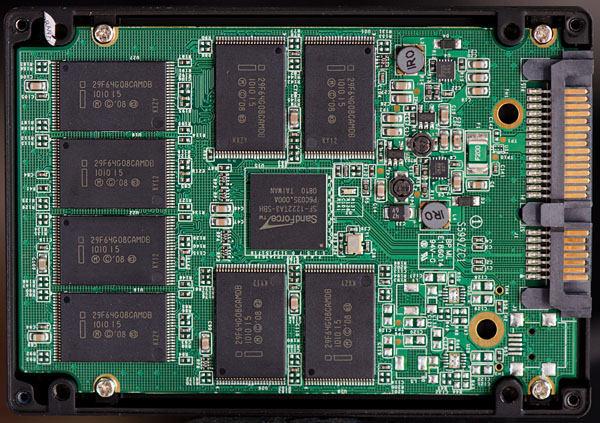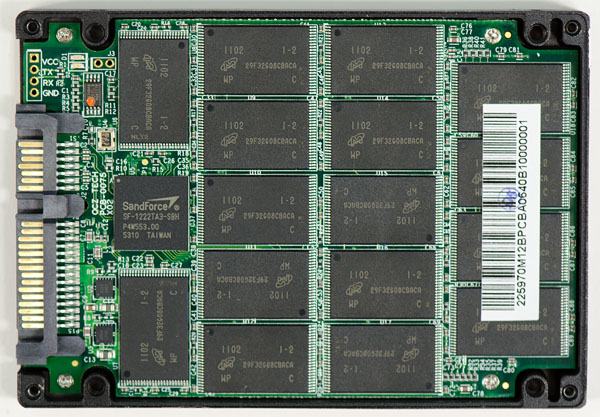The OCZ Vertex 3 Review (120GB)
by Anand Lal Shimpi on April 6, 2011 6:32 PM ESTThe Real Issue
While I was covering MWC a real issue with OCZ's SSDs erupted back home: OCZ aggressively moved to high density 25nm IMFT NAND and as a result was shipping product under the Vertex 2 name that was significantly slower than it used to be. Storage Review did a great job jumping on the issue right away.
Let's look at what caused the issue first.
When IMFT announced the move to 25nm it mentioned a doubling in NAND capacity per die. At 25nm you could now fit 64Gbit of MLC NAND (8GB) on a single die, twice what you could get at 34nm. With twice the density in the same die area, costs could come down considerably.

An IMFT 25nm 64Gbit (8GB) MLC NAND die
Remember NAND manufacturing is no different than microprocessor manufacturing. Cost savings aren't realized on day one because yields are usually higher on the older process. Newer wafers are usually more expensive as well. So although you get ~2x density improvement going to 25nm, your yields are lower and wafers are more expensive than they were at 34nm. Even Intel was only able to get a maximum of $110 decrease in price when going from the X25-M G2 to the SSD 320.
OCZ was eager to shift to 25nm. Last year SandForce was the first company to demonstrate 25nm Intel NAND on an SSD at IDF, clearly the controller support was there. As soon as it had the opportunity to, OCZ began migrating the Vertex 2 to 25nm NAND.
SSDs are a lot like GPUs, they are very wide, parallel beasts. While a GPU has a huge array of parallel cores, SSDs are made up of arrays of NAND die working in parallel. Most controllers have 8 channels they can use to talk to NAND devices in parallel, but each channel can often have multiple NAND die active at once.

A Corsair Force F120 using 34nm IMFT NAND
Double the NAND density per die and you can guess what happened next - performance went down considerably at certain capacity points. The most impacted were the smaller capacity drives, e.g. the 60GB Vertex 2. Remember the SF-1200 is only an 8-channel controller so it only needs eight devices to technically be fully populated. However within a single NAND device, multiple die can be active concurrently and in the first 25nm 60GB Vertex 2s there was only one die per NAND package. The end result was significantly reduced performance in some cases, however OCZ failed to change the speed ratings on the drives themselves.
The matter is complicated by the way SandForce's NAND redundancy works. The SF-1000 series controllers have a feature called RAISE that allows your drive to keep working even if a single NAND die fails. The controller accomplishes this redundancy by writing parity data across all NAND devices in the SSD. Should one die fail, the lost data is reconstructed from the remaining data + parity and mapped to a new location in NAND. As a result, total drive capacity is reduced by the size of a single NAND die. With twice the density per NAND die in these early 25nm drives, usable capacity was also reduced when OCZ made the switch with Vertex 2.
The end result was that you could buy a 60GB Vertex 2 with lower performance and less available space without even knowing it.

A 120GB Vertex 2 using 25nm Micron NAND
After a dose of public retribution OCZ agreed to allow end users to swap 25nm Vertex 2s for 34nm drives, they would simply have to pay the difference in cost. OCZ realized that was yet another mistake and eventually allowed the swap for free (thankfully no one was ever charged), which is what should have been done from the start. OCZ went one step further and stopped using 64Gbit NAND in the 60GB Vertex 2, although drives still exist in the channel since no recall was issued.
OCZ ultimately took care of those users who were left with a drive that was slower (and had less capacity) than they thought they were getting. But the problem was far from over.










153 Comments
View All Comments
martixy - Monday, April 11, 2011 - link
So... the SSD market is shaping up to the just about the most confusing and volatile market out there.At least that's the impression I get from the articles here. I mean you'd probably need your very own market research team if you want to get a good deal on an SSD.
Meh...
gixxer - Monday, April 11, 2011 - link
So if you have read all the comments up to this point with the OCZ verus Intel debate.Where would you spend your money?
A vertex 3, Intel 320, or Intel 510
MamiyaOtaru - Tuesday, April 12, 2011 - link
it's not scientific, but after looking at the newegg user review averages, not touching anything other than inteltech6 - Monday, April 11, 2011 - link
Thank you Anand - you're a real asset to the tech community!While OCZ has a potentially great product, they are really proving to be their own worst enemy. Until they demonstrate some maturity I will choose an Intel 320 instead. It may not be the newest or fastest but the G1/G2/G3 series drives have so far proven to be reasonably reliable and perform as advertised.
ClagMaster - Monday, April 11, 2011 - link
Seems to me the Intel 510 offers better mainstream performance than the Vertex 3.And I also think Intel does a better job with balancing firmware with memory technology, and has better configuration control of what memory is used for their SSD's.
I think suffering a 20% risk of getting a Vertex 3 SSD with slower memory is too high for what I pay for such a device
qax - Wednesday, April 13, 2011 - link
This sort of commitment can make me wanna buy OCZ next time, thats for sure.Although they shipped slow drives, they accept the responsability, and thats a big thing in my world.
I´ve totaly stopped buying som vendors that are too cheap, resulting in useless/nonexisting support.
Same reason why i allways buy from a psysical shop and never from internetshops.
I need psysical adress not too far from my own adress, where i can turn in a faulty product.
For me an SSD driver will allways be used for OS, programs and games. For space i would have HDD.
So space on SSD is no concern.
javishd - Wednesday, April 13, 2011 - link
I think I'm not alone here. Waiting to buy after some real comparisons of the $300 120gb range. We look to you for help with the decision! Thanks for your long term commitment to ssd. I've been on board since the x25 g1, and I really appreciate all the info from you guys. I'll keep checking every day hoping....alexb1 - Wednesday, April 13, 2011 - link
Anand, THANK YOU VERY VERY MUCH!Honestly, there is NO ONE ELSE in the IT industry advocating for enthusiast consumers like you... kudos!
I am A VICTIM of OCZ Marketing of Vertex2, and got a 80GB recently that basically does EXTREMELY POOR compared to ALL benchmarks. To top it all off, it is NOT part of the *recall* drives as its size hasn't been affected with the 25nm transition... so I am just about to return and take a 15% restocking fee.
Now, my question is... should I even bother looking for a 34nm drive, or one of the newer 25nm drives would just do ok as boot drive in Win7? My MOST CONCERN is reliability and longevity.
I can either get a F60-A (25nm), F60 (34nm), or OCZ Vertex2 (25nm)... The 25nm being $30-40 CHEAPER!
faster - Thursday, April 14, 2011 - link
Today the Intel 510 250GB drive mentioned in these benchamarks can be had at newegg for $615 (-$40 off promo until 4/19, $575).The Egg also has the Revo Drive X2 240GB at $570 (was $680).
So we as consumers have the new 250 GB 6Gbps SATA3 SSD drives vs. the 240GB PCIE X4 integrated bootable RAID 0 card within $5 of the same price point.
Certainly a bootable add in card is not a straight comparison to a single SSD drive, but at the same price point, in the cutting edge overpriced enthusiast level, it is a sensible comparison.
Anandtech should put the RevoX2 in these benchmark charts to show how they measure up. It would be more interesting than comparing a WD Raptor represented by tiny slivers on the performance comparisons. I believe, generally speaking, that the Revo would come away with faster read speeds and be neck in neck with fastest SSD drives on write speeds. AnandTech had or has a RevoDrive that they reviewed in the past. Is that thing still laying around?
daidaloss - Thursday, April 14, 2011 - link
@fasterI second your petition to Anand to put the Revo2 on the charts, so us, real power user, would have an idea how do SSDs compare with PCI raid cards.
Also, sure would be interesting to see how do SSD compare to ram drives like the HyperDrive5. Supposedly this thing boots up in 4 seconds. Should be interesting to compare such a system with a modern SSD.